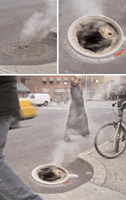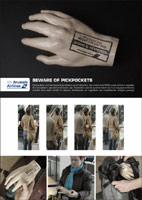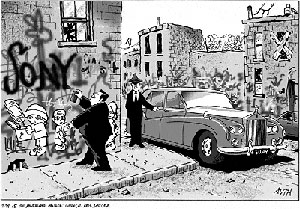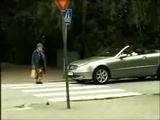
 This outdoor advertisement transforming a New York City manhole into a steaming cup of coffee was apparently created by Saatchi & Saatchi for their client Folgers. The question is: was this actually done in real life (i.e. were vinyl covers placed on top of manholes), or has the picture simply been photoshopped? The picture itself seems to have been first posted at coloribus.com, and someone has posted a comment there claiming to be from Saatchi & Saatchi and confirming that the coffee-manhole campaign was real. But I can't find anything official from Saatchi & Saatchi in which they take credit for the campaign. Still, my hunch is that it's real.
This outdoor advertisement transforming a New York City manhole into a steaming cup of coffee was apparently created by Saatchi & Saatchi for their client Folgers. The question is: was this actually done in real life (i.e. were vinyl covers placed on top of manholes), or has the picture simply been photoshopped? The picture itself seems to have been first posted at coloribus.com, and someone has posted a comment there claiming to be from Saatchi & Saatchi and confirming that the coffee-manhole campaign was real. But I can't find anything official from Saatchi & Saatchi in which they take credit for the campaign. Still, my hunch is that it's real. This photo of a London bus displaying Google Adsense ads was posted on the Digital Point Forums on April 2nd. It since has been making its way around the internet. It's definitely photoshopped. The white google ads show no variation in color or shadowing. It was probably some kind of late April Fool's Day joke. Still, it would be a clever form of outdoor advertising. (via Fresh Creation)
This photo of a London bus displaying Google Adsense ads was posted on the Digital Point Forums on April 2nd. It since has been making its way around the internet. It's definitely photoshopped. The white google ads show no variation in color or shadowing. It was probably some kind of late April Fool's Day joke. Still, it would be a clever form of outdoor advertising. (via Fresh Creation) Brussels Airlines has been experimenting with a bizarre campaign to raise awareness about the threat of getting pickpocketed in airports. Their agents have been covertly slipping plastic hands into the bags of people who aren't paying enough attention to what's going on around them. Imagine opening up your bag and finding a hand in there. I think I'd freak out. The campaign was created for Brussels Airlines by the agency LG&F. (via Coolzor)
Brussels Airlines has been experimenting with a bizarre campaign to raise awareness about the threat of getting pickpocketed in airports. Their agents have been covertly slipping plastic hands into the bags of people who aren't paying enough attention to what's going on around them. Imagine opening up your bag and finding a hand in there. I think I'd freak out. The campaign was created for Brussels Airlines by the agency LG&F. (via Coolzor)  In Hippo Eats Dwarf I discuss Video News Releases (VNRs) and how their use means that a lot of the news we see on TV is either advertising or propaganda in disguise. (VNRs are video segments created by corporations or the government, that are then aired on TV news, often without their true source ever being revealed). RAW STORY reports that "over a ten month span, 77 television stations from all across the nation aired video news releases without informing their viewers even once that the reports were actually sponsored content."
In Hippo Eats Dwarf I discuss Video News Releases (VNRs) and how their use means that a lot of the news we see on TV is either advertising or propaganda in disguise. (VNRs are video segments created by corporations or the government, that are then aired on TV news, often without their true source ever being revealed). RAW STORY reports that "over a ten month span, 77 television stations from all across the nation aired video news releases without informing their viewers even once that the reports were actually sponsored content."  The debate over the identity of Mr. Six, that crazy old guy who used to dance around in the commercials for Six Flags (Six Flags no longer uses him), has raged on for quite a while. Many were convinced it was Jaleel White, the actor who played Urkel on Family Matters. Others thought Mr. Six was played by a woman. But no one really had any clue, and Six Flags certainly wasn't telling. Now, at last, the mystery seems like it might have been solved. Paul Davidson has posted on his blog that Mr. Six was Danny Teeson, an actor who now appears on Queer Eye for the Straight Girl:
The debate over the identity of Mr. Six, that crazy old guy who used to dance around in the commercials for Six Flags (Six Flags no longer uses him), has raged on for quite a while. Many were convinced it was Jaleel White, the actor who played Urkel on Family Matters. Others thought Mr. Six was played by a woman. But no one really had any clue, and Six Flags certainly wasn't telling. Now, at last, the mystery seems like it might have been solved. Paul Davidson has posted on his blog that Mr. Six was Danny Teeson, an actor who now appears on Queer Eye for the Straight Girl: Remember this racy PUMA ad? It was circulating around the internet back in early 2003. The rumor was that it had appeared in the Brazilian version of Maxim, but PUMA officials soon denied this, and further stated that their company was not responsible for it in any way. PUMA then threatened to sue anyone who posted it. (No one ever got sued.) This led many bloggers to speculate that PUMA was, in fact, the creator of it, and had spread it as a subviral advertisement (i.e. a viral ad secretly produced by a company, which the company denies any knowledge of... allowing them to experiment with more controversial forms of marketing). But despite this speculation, the question of who created the image remained unresolved, until now. Peter Kim, former PUMA International Marketing Manager, has disclosed the inside story on his blog:
Remember this racy PUMA ad? It was circulating around the internet back in early 2003. The rumor was that it had appeared in the Brazilian version of Maxim, but PUMA officials soon denied this, and further stated that their company was not responsible for it in any way. PUMA then threatened to sue anyone who posted it. (No one ever got sued.) This led many bloggers to speculate that PUMA was, in fact, the creator of it, and had spread it as a subviral advertisement (i.e. a viral ad secretly produced by a company, which the company denies any knowledge of... allowing them to experiment with more controversial forms of marketing). But despite this speculation, the question of who created the image remained unresolved, until now. Peter Kim, former PUMA International Marketing Manager, has disclosed the inside story on his blog:
 I'm about five days late posting this, but better late than never. An advertisement for an "Extra Virgin Mary Statue" slipped by the editors of the conservative Catholic magazine, America. The advertisement offered "a stunning ... statue of the Virgin Mary standing atop a serpent wearing a delicate veil of latex." The "delicate veil of latex" was a blue condom. America's editors didn't examine the accompanying photo closely enough to realize this. And so the ad ran in the December 5 edition. People who contacted the seller were told the ad was meant "as an assault on Catholic faith and devotion." I don't know who the artist was who created the ad. Maybe it was Banksy.
I'm about five days late posting this, but better late than never. An advertisement for an "Extra Virgin Mary Statue" slipped by the editors of the conservative Catholic magazine, America. The advertisement offered "a stunning ... statue of the Virgin Mary standing atop a serpent wearing a delicate veil of latex." The "delicate veil of latex" was a blue condom. America's editors didn't examine the accompanying photo closely enough to realize this. And so the ad ran in the December 5 edition. People who contacted the seller were told the ad was meant "as an assault on Catholic faith and devotion." I don't know who the artist was who created the ad. Maybe it was Banksy.
 In order to promote its new handheld game player, Sony is paying artists to spray paint fake graffiti on buildings in major cities. (They're also paying the building owners for the right to spray paint the graffiti, which consists of images of spaced-out kids playing with the new handheld device.) But according to an article in Wired, the fake graffiti has provoked the anger of some city residents, who have spray painted over the images messages such as "Get out of my city," and "Fony." The Wired article points out that this isn't the first time advertisers have created fake graffiti: "In 2001, IBM paid Chicago and San Francisco more than $120,000 in fines and clean-up costs after its advertising agency spray-painted Linux advertisements on the cities' sidewalks." In Hippo Eats Dwarf I also briefly discuss how The Gap once spray-painted fake graffiti on its store windows. The phenomenon is called faux-rilla marketing (i.e. guerrilla marketing that relies on fake elements).
In order to promote its new handheld game player, Sony is paying artists to spray paint fake graffiti on buildings in major cities. (They're also paying the building owners for the right to spray paint the graffiti, which consists of images of spaced-out kids playing with the new handheld device.) But according to an article in Wired, the fake graffiti has provoked the anger of some city residents, who have spray painted over the images messages such as "Get out of my city," and "Fony." The Wired article points out that this isn't the first time advertisers have created fake graffiti: "In 2001, IBM paid Chicago and San Francisco more than $120,000 in fines and clean-up costs after its advertising agency spray-painted Linux advertisements on the cities' sidewalks." In Hippo Eats Dwarf I also briefly discuss how The Gap once spray-painted fake graffiti on its store windows. The phenomenon is called faux-rilla marketing (i.e. guerrilla marketing that relies on fake elements). Nike has a new ad featuring Brazilian soccer star Ronaldinho Gaucho. In the ad Ronaldinho puts on a pair of Nikes, juggles the ball a few times, and then kicks the ball towards the goal so that it hits the crossbar and bounces directly back to him. He does this four times in a row. And it's all shot in a single take. This has inspired a lot of discussion on the net, because it's hard to believe anyone could be skilled enough to do this. In an article posted on the BBC (in Portuguese... I read it via AltaVista Translate) Ronaldinho swears that the scene is real, although the reporters interviewing him refuse to believe him. Given that it's an ad, I would assume it's fake, since one should always assume that what you see in ads is bogus, unless it's proven otherwise.
Nike has a new ad featuring Brazilian soccer star Ronaldinho Gaucho. In the ad Ronaldinho puts on a pair of Nikes, juggles the ball a few times, and then kicks the ball towards the goal so that it hits the crossbar and bounces directly back to him. He does this four times in a row. And it's all shot in a single take. This has inspired a lot of discussion on the net, because it's hard to believe anyone could be skilled enough to do this. In an article posted on the BBC (in Portuguese... I read it via AltaVista Translate) Ronaldinho swears that the scene is real, although the reporters interviewing him refuse to believe him. Given that it's an ad, I would assume it's fake, since one should always assume that what you see in ads is bogus, unless it's proven otherwise.
 Breath Capture is a company that's selling air. Or more specifically, they're selling tubes. The customers themselves are supposed to provide the air by breathing into the tubes. They promote these tubes as a way to "Capture the breath of a loved one or friend and keep them close. Forever." So it's a gimmick, kind of like pet rocks, or buying land on the Moon. But what gets me is this claim the company makes on it site:
Breath Capture is a company that's selling air. Or more specifically, they're selling tubes. The customers themselves are supposed to provide the air by breathing into the tubes. They promote these tubes as a way to "Capture the breath of a loved one or friend and keep them close. Forever." So it's a gimmick, kind of like pet rocks, or buying land on the Moon. But what gets me is this claim the company makes on it site: Someone emailed me a videoclip titled "Road Rage". It shows an old woman slowly crossing a road, as a guy in a sports car lays on the horn, trying to get her to hurry up. I won't ruin the ending, but it's pretty amusing. However, the video (in the version I received) appears to be an unscripted scene accidentally caught on video by an amateur. There's no identifying information to suggest otherwise. But since I was curious about whether the scene really was unstaged, I managed to find it on Google Video. Their version was a few seconds longer, preserving the ending in which it's revealed to be an ad for IKEA. So apparently the scene was staged. It's still funny. But, I have no clue how the scene is supposed to inspire anyone to shop at IKEA.
Someone emailed me a videoclip titled "Road Rage". It shows an old woman slowly crossing a road, as a guy in a sports car lays on the horn, trying to get her to hurry up. I won't ruin the ending, but it's pretty amusing. However, the video (in the version I received) appears to be an unscripted scene accidentally caught on video by an amateur. There's no identifying information to suggest otherwise. But since I was curious about whether the scene really was unstaged, I managed to find it on Google Video. Their version was a few seconds longer, preserving the ending in which it's revealed to be an ad for IKEA. So apparently the scene was staged. It's still funny. But, I have no clue how the scene is supposed to inspire anyone to shop at IKEA.
 Not many people like rats. But the members of the Great Pointed Archer Society do. As they proclaim on their very slick website: The immediate goal of this website is to replace the offensive name ‘rat’ with the untainted, and beautiful name Great Pointed Archer. By doing away with this all-to-common slur, we can begin to repair centuries of disrespect and hatred. After all, it’s not their fault they live in the sewer and eat trash.
Not many people like rats. But the members of the Great Pointed Archer Society do. As they proclaim on their very slick website: The immediate goal of this website is to replace the offensive name ‘rat’ with the untainted, and beautiful name Great Pointed Archer. By doing away with this all-to-common slur, we can begin to repair centuries of disrespect and hatred. After all, it’s not their fault they live in the sewer and eat trash. Hoax forum regulars are familiar with Cillit Bang (a brand of cleaner) and its over-the-top advertisements. Now it seems that Barry Scott, the fictional Cillit Bang spokesperson, has materialized in cyber space with his very own weblog. As if that wasn't enough, Barry Scott has also begun leaving comments on other people's weblogs. Tom Coates, of plasticbag.org, reports that after he posted an entry about his father, whom he hasn't seen in over thirty years, Barry Scott left a comment (as well as a link to cillitbang.com):
Hoax forum regulars are familiar with Cillit Bang (a brand of cleaner) and its over-the-top advertisements. Now it seems that Barry Scott, the fictional Cillit Bang spokesperson, has materialized in cyber space with his very own weblog. As if that wasn't enough, Barry Scott has also begun leaving comments on other people's weblogs. Tom Coates, of plasticbag.org, reports that after he posted an entry about his father, whom he hasn't seen in over thirty years, Barry Scott left a comment (as well as a link to cillitbang.com):